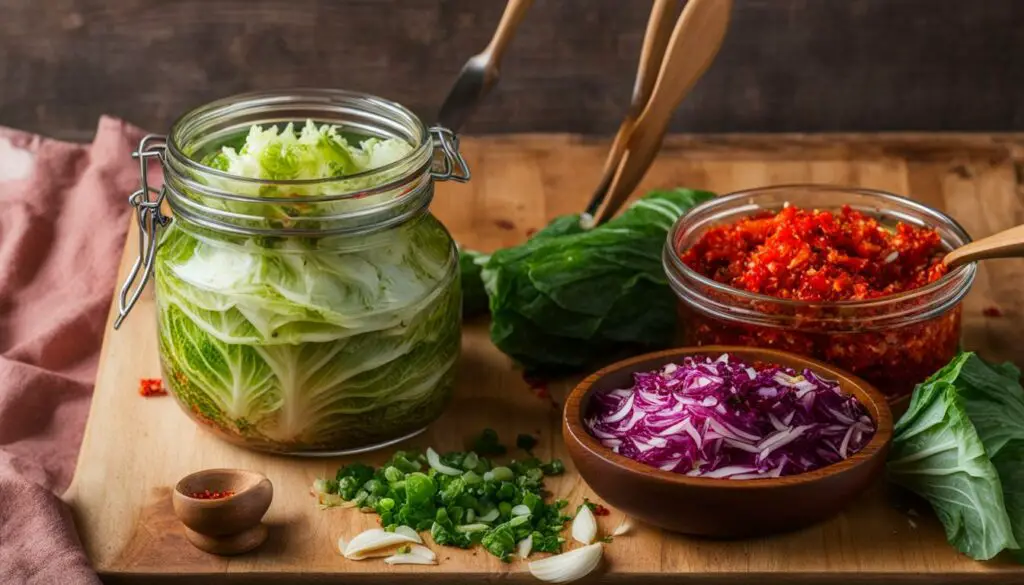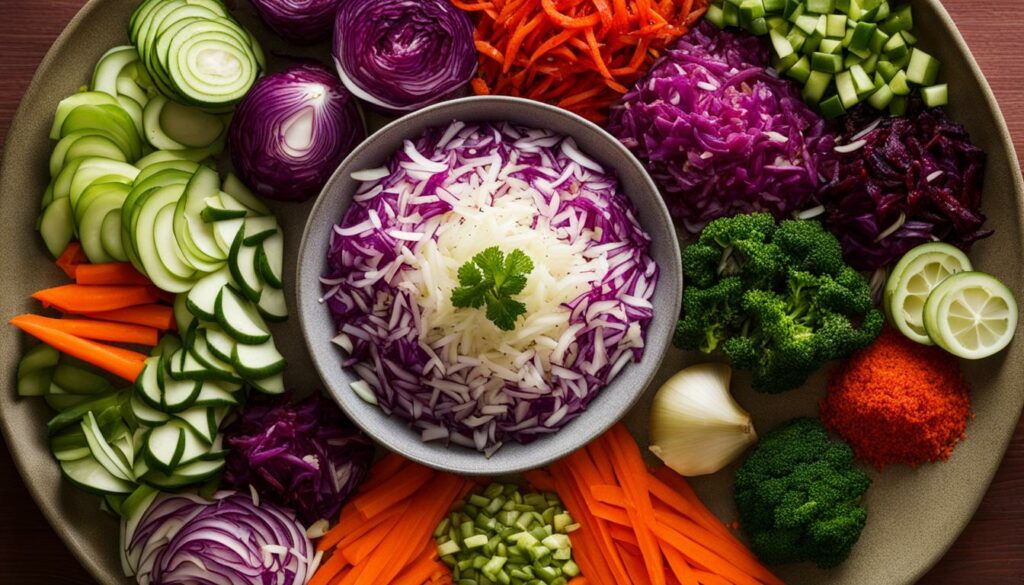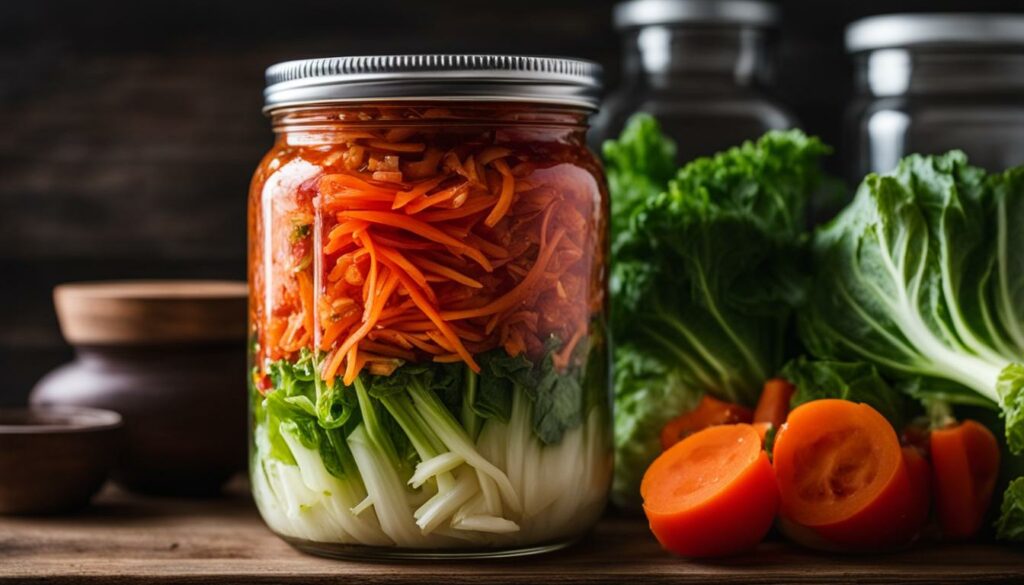If you are a vegan or simply prefer not to use fish sauce in your cooking, you might assume that you can’t enjoy the delicious flavors of traditional Korean dish – kimchi. However, we have good news for you! With this easy recipe, you can make your own vegan-friendly kimchi at home, without compromising on taste.
Kimchi is a fermented side dish made with vegetables, most commonly cabbage and radish. It’s a staple in Korean cuisine and is enjoyed for its tangy, spicy, and umami flavors. Traditionally, fish sauce is used to add an extra umami kick to the kimchi. However, there are several vegan and vegetarian-friendly alternatives that can achieve the same great taste.
Follow our step-by-step guide to making your own homemade kimchi without fish sauce, and impress your friends and family with your culinary skills!
Key Takeaways
- Kimchi is a traditional Korean side dish made from fermented vegetables, most commonly cabbage and radish.
- Fish sauce is a common component in traditional kimchi recipes, but there are several vegan and vegetarian-friendly substitutes available.
- This easy recipe will allow you to make delicious vegan-friendly kimchi without compromising on taste.
- Follow our step-by-step guide to making your own homemade kimchi without fish sauce.
- Experiment with different variations and share your homemade kimchi with family and friends.

Understanding Kimchi and Its Ingredients
If you’re a vegan or vegetarian, you may have been hesitant to try kimchi because of its traditional use of fish sauce. However, there are substitutes that can be used to achieve that umami taste that is typically associated with the dish.
Kimchi is a traditional Korean side dish that is highly nutritious and packed with probiotics. It is typically made from fermented vegetables such as cabbage and radish, which are mixed with a variety of seasonings to create a distinctive and complex flavor.
While fish sauce is a common ingredient in many kimchi recipes, there are plenty of vegan and vegetarian-friendly substitutes available. Some examples include miso paste, soy sauce, and mushroom sauce. These substitutes can help you achieve that umami taste without using animal products or compromising the flavor of the dish.
What Makes Kimchi Vegan or Vegetarian?
Kimchi can be vegan or vegetarian depending on the ingredients that are used. Traditional kimchi recipes often include fish sauce, which is made from fermented fish and salt. For a kimchi dish to be vegan or vegetarian, the fish sauce needs to be replaced with a suitable substitute that provides that umami taste.
Many vegan and vegetarian kimchi recipes recommend using miso paste, which is made from fermented soybeans and provides a similar taste to fish sauce. Others suggest using soy sauce or coconut aminos, which are both vegan-friendly options.
Whether you’re a vegan or vegetarian, there are many ways to enjoy kimchi without compromising your dietary preferences.
“Kimchi is a traditional Korean side dish that is highly nutritious and packed with probiotics.”
Ingredients Needed for Vegan Kimchi
Before you start making your vegan kimchi, make sure you have all the required ingredients at hand. Here is a checklist of what you need:
| Ingredient | Amount |
|---|---|
| Miso paste | 1/4 cup |
| Gochugaru (Korean red pepper flakes) | 1/2 cup |
| Garlic, minced | 6 cloves |
| Ginger, grated | 2 tablespoons |
| Cabbage, chopped into bite-sized pieces | 1 head |
| Radish, sliced thinly | 1 cup |
| Salt | 1/4 cup |
| Sugar | 1 tablespoon |
| Water | 4 cups |
Miso paste and gochugaru can be found at your local Asian market or online. Make sure to use authentic Korean gochugaru for the best flavor. Fresh garlic and ginger are also recommended for optimal taste. The cabbage and radish can be purchased at your local grocery store.

Once you have all your ingredients, you’re ready to move on to the next step – creating your vegan kimchi!
Step-by-Step Guide to Making Vegan Kimchi
Now that you have all the necessary ingredients, it’s time to start making your very own vegan kimchi! Follow these step-by-step instructions:
- Start by washing and draining a medium-sized head of cabbage. Cut it into quarters and remove the core. Slice the cabbage into bite-sized pieces and place them in a large bowl.
- Sprinkle the cabbage with ¼ cup of salt and 1 tablespoon of sugar. Massage the salt and sugar into the cabbage for about 5 minutes until it starts to release water. Let the cabbage sit for about an hour until it wilts and releases more water.
- In the meantime, prepare the kimchi paste. In a blender, combine 3 tablespoons of gochugaru, 2 tablespoons of miso paste, 4 cloves of minced garlic, and 1 tablespoon of grated ginger. Add ¼ cup of water and blend until everything is well combined.
- Once the cabbage has wilted, rinse it under cold water to remove the excess salt. Drain the cabbage and return it to the bowl. Add 1 cup of chopped radish and the kimchi paste. Mix everything well, making sure the vegetables are coated with the paste.
- Transfer the kimchi to a jar. Press down the vegetables with a spoon to remove any air pockets. Pour any remaining liquid over the top until it covers the vegetables by about 1 inch.
- Cover the jar with a lid and let it sit at room temperature for 1-5 days. Check the kimchi every day and press down the vegetables to make sure they are submerged in the brine. The longer you ferment the kimchi, the tangier it will become. Once it reaches your desired level of tanginess, transfer it to the fridge to slow down the fermentation process.
That’s it! Making vegan kimchi is straightforward and easy to do at home. Remember to be patient during the fermentation process and adjust the level of spice to your liking. Enjoy your homemade kimchi in salads, sandwiches, rice bowls, or simply as a standalone side dish.
Tips for Making the Best Vegan Kimchi
Congratulations on making your own vegan kimchi! Now that you’ve mastered the recipe, it’s time to enhance your skills and create the best possible batch of kimchi. Here are some helpful tips to take your vegan kimchi to the next level:
Fermentation Process
Fermentation is a crucial step in making kimchi. Ensure that your fermentation container is completely sealed to prevent air from entering and causing spoilage. Additionally, keep the container in a cool, dark place, around 65-75°F for optimal fermentation. Be patient and allow the kimchi to ferment for at least three days before refrigerating.
Vegan Kimchi Tips
If you’re new to making kimchi, start with a small batch and experiment with different flavor variations to find your favorite. Use only fresh and high-quality ingredients to achieve the best possible flavor. When packing the kimchi into the jar, press down firmly to release any air bubbles and ensure that the vegetables are fully submerged in the brine.
Flavor Variations
One of the best things about making kimchi is the ability to customize the flavor to your preferences. Here are some popular variations you can try:
| Ingredient | Description |
|---|---|
| Carrots | Adds a slightly sweet taste and bright color to the kimchi. |
| Green onions | Provides a fresh onion flavor and crunch. |
| Pears | Offers a subtle sweetness and helps tenderize the cabbage. |
| Apples | Gives a mild sweetness and acidity to the kimchi. |
Experiment with these ingredients or others that you may like. Remember to keep track of the ingredients and ratios you use so that you can recreate successful batches.
By following these tips, you’ll be well on your way to becoming a kimchi-making expert. Enjoy your homemade vegan kimchi with different dishes to elevate your meals. Remember, practice makes perfect, and don’t be afraid to experiment with new flavors!
Storing and Enjoying Your Vegan Kimchi
Now that you’ve made a delicious batch of vegan kimchi, it’s important to store it properly to maintain its flavor and freshness.
The best way to store your kimchi is to keep it in an airtight container or jar in the refrigerator. This will slow down the fermentation process and keep the flavors intact. Your vegan kimchi will keep for up to a month in the fridge, but it’s best to consume it within the first two weeks.
There are many ways to enjoy your homemade vegan kimchi. You can eat it as a side dish with rice or noodles, or add it to soups, stews, sandwiches, and salads for a flavorful kick. You can also use it as a topping for pizzas or tacos, or even mix it in with scrambled eggs for a tasty breakfast dish.
Here are some serving suggestions for your vegan kimchi:
- Top off your avocado toast with a few scoops of kimchi.
- Make a kimchi grilled cheese sandwich by adding it to your favorite cheese and bread combination.
- Use it as a condiment for your veggie burgers or hot dogs.
- Mix it into your fried rice or noodle stir-fry for extra flavor.
Experiment with different ways to incorporate your homemade vegan kimchi into your meals and discover new and exciting flavor combinations. Don’t be afraid to get creative!

Troubleshooting Common Issues with Vegan Kimchi
While making your own kimchi can be a fun and rewarding experience, sometimes things don’t go as planned. Here are some common issues you may encounter during the fermentation process and how to troubleshoot them:
Problem: Your kimchi isn’t fermenting
If you find that your kimchi isn’t fermenting, it could be due to a few reasons. First, make sure you’re storing your kimchi in a warm, dark place. The ideal temperature for fermentation is between 68-77°F. If the temperature is too low, the fermentation process will slow down or stop altogether.
Another issue could be that your kimchi is too dry. During fermentation, the vegetables release water which creates a brine that helps the fermentation process. Make sure you’re using enough salt to draw out the moisture from the vegetables, and that the vegetables are covered with the brine to prevent dryness.
Problem: Your kimchi is too salty
If your kimchi is too salty, it’s likely that you added too much salt during the preparation process. To fix this issue, you can add more water to dilute the saltiness. Alternatively, you could add more vegetables to the mix to balance out the flavor.
Problem: Your kimchi is too sour
If your kimchi tastes too sour, it means that the fermentation process has gone on for too long. To prevent this from happening, it’s important to check on your kimchi regularly and taste it to ensure it’s fermenting to your liking. If your kimchi has already become too sour, you can still use it in cooking by adding it to stews and soups where the sourness can be balanced out by other ingredients.
Problem: Your kimchi has mold
While mold on your kimchi may be alarming, it’s not necessarily a sign that your kimchi is spoiled. Surface mold can sometimes appear on the top layer of the kimchi due to exposure to air. Simply scoop out the moldy bits and discard them, taking care to keep the rest of the kimchi below the brine level. If the mold is extensive or appears throughout the kimchi, it’s best to discard the entire batch.
Remember, making kimchi is a learning process, and even the most experienced kimchi makers encounter issues from time to time. Don’t be discouraged by setbacks – use these troubleshooting tips to help you create the perfect batch of vegan kimchi.
Conclusion
Enjoy the Fruits of Your Labor
Now that you’ve mastered the art of making vegan kimchi, it’s time to savor the delicious flavors of your homemade creation. Whether you enjoy it as a standalone side dish or incorporate it into your favorite recipes, you can take pride in knowing that your kimchi is vegan-friendly and made from quality ingredients.
Experimentation is Key
Don’t be afraid to experiment with different variations of your vegan-friendly kimchi recipe. You can adjust the spice level to your liking or try adding new vegetables to create your own unique twist. The possibilities are endless when it comes to making kimchi, so have fun and let your creativity run wild.
Share the Love
Sharing is caring, so why not share your homemade kimchi with family and friends? You can introduce them to the wonders of this traditional Korean dish and show them how easy it is to make a vegan-friendly version. Who knows, you may even inspire them to try their hand at making their own batch of kimchi.
Keep on Fermenting
Making kimchi is a process that requires patience and attention. While you may encounter some challenges along the way, don’t give up. Troubleshoot any issues that arise and keep on fermenting. With practice, you’ll become a kimchi-making pro in no time.
Thank you for joining us on this journey to make vegan-friendly kimchi. We hope you enjoy the fruits of your labor and continue to experiment with this delicious dish. Don’t forget to share your creations with us and happy fermenting!